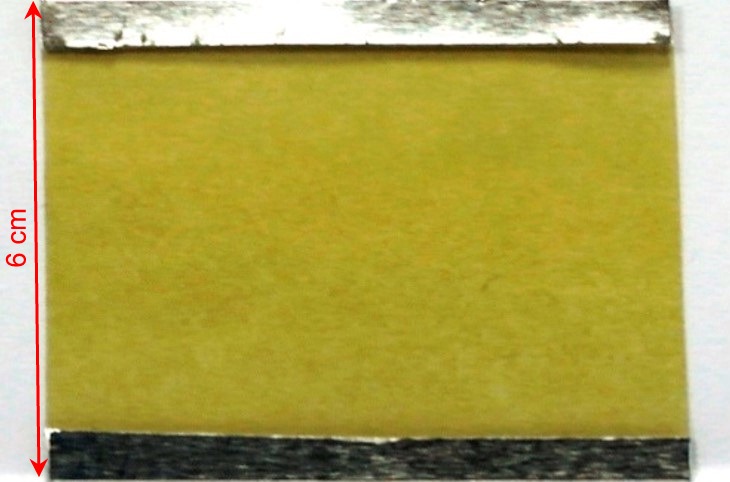Katja Heinze receives research award for intelligent food packaging with freshness indicator

Prototype of an intelligent foil for food packaging in its original state photo: Dr. Philip Heier / group of Prof. Katja Heinze
The Mainz chemistry professor Katja Heinze and her Luxembourg cooperation partner Dr. Patrick Choquet have received the Interregional Research Award for the development of novel, intelligent foils for food packaging. This is the sixth time this award worth EUR 35,000 has been presented.
Its purpose is to promote collaboration in cross-border research projects and reinforce the profile of the interregional research landscape. “To offer capable partners the best conditions for cross-border cooperation – that is the main aim of our mutual cooperation strategy in the sector of higher education and research in the Greater Region.
The SURFAMINE research project that has been honored with the 2014 Interregional Research Award is an outstanding example of the potential that lies in cross-border cooperation,” emphasized State Secretary Professor Thomas Deufel of the Ministry of Education, Science, Continuing Education, and Culture of Rhineland-Palatinate.
Working in collaboration with Dr. Patrick Choquet from the Centre de Recherche Public in Belvaux, Luxembourg on the SURFAMINE project, the work group of Professor Katja Heinze of the Institute of Inorganic Chemistry and Analytical Chemistry of Johannes Gutenberg University Mainz (JGU) has developed innovative foils for foodstuff packaging.
“In view of the series of food scandals that have occurred in recent years, there is an increased interest in monitoring food freshness and in food safety,” Heinze explained the background to the research project. The aim of the three-year SURFAMINE project was to develop a form of food packaging that would display real-time information on the status of the packaged items.
The idea was to create an intelligent foil that would interact with the atmosphere within the package and display information about its composition by means of colorimetric signals in the form of a change of color from green to red, for example.
In order to achieve this challenging objective, a number of institutes and commercial partners joined forces. In addition to Professor Katja Heinze's group at the Institute of Inorganic Chemistry and Analytical Chemistry of Mainz University, other project participants are the Department of Research and Material Analysis and the Department of Environmental and Agrarian Sciences of the Centre de Recherche Public – Gabriel Lippmann in Belvaux in Luxembourg, the Novelis Foil Innovation Center, also in Belvaux, and the ArcelorMittal Plasma Research Group in Liège in Belgium.
Working together in the SURFAMINE project, the teams have designed, synthesized, and employed novel dyes that are used to give the foils their color. These colors change on interaction with amines that are released when the packaged foodstuffs undergo bacterial decomposition and thus show how fresh the foodstuffs are.
In addition, a new and more environmentally-friendly coating process has been developed with which even large surfaces can be covered with the intelligent materials. The multinational cooperation project was financed by the Luxembourg Fonds National de la Recherche.
The Interregional Research Award is given to research networks that have at least a bilateral and preferably multilateral cross-border orientation in the Greater Region where France, Luxembourg, Belgium, and Germany meet. The project must be of cross-border interest in the Greater Region and the award is intended to pay tribute to new projects that strengthen public awareness and the attractiveness of the Greater Region.
urther information:
Professor Dr. Katja Heinze
Institute of Inorganic Chemistry and Analytical Chemistry
Johannes Gutenberg University Mainz (JGU)
D 55099 Mainz, GERMANY
phone +49 6131 39-25886
fax +49 6131 39-27277
e-mail: katja.heinze@uni-mainz.de
https://www.blogs.uni-mainz.de/fb09ak-heinze/
Weitere Informationen:
http://www.uni-mainz.de/presse/17824_ENG_HTML.php – press release ;
https://www.blogs.uni-mainz.de/fb09ak-heinze/ – Group of Prof. Heinze at Mainz University
Media Contact
All latest news from the category: Awards Funding
Newest articles

NASA: Mystery of life’s handedness deepens
The mystery of why life uses molecules with specific orientations has deepened with a NASA-funded discovery that RNA — a key molecule thought to have potentially held the instructions for…

What are the effects of historic lithium mining on water quality?
Study reveals low levels of common contaminants but high levels of other elements in waters associated with an abandoned lithium mine. Lithium ore and mining waste from a historic lithium…

Quantum-inspired design boosts efficiency of heat-to-electricity conversion
Rice engineers take unconventional route to improving thermophotovoltaic systems. Researchers at Rice University have found a new way to improve a key element of thermophotovoltaic (TPV) systems, which convert heat…



